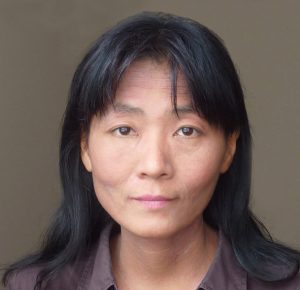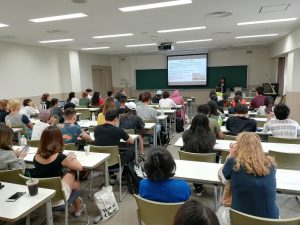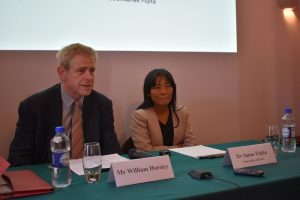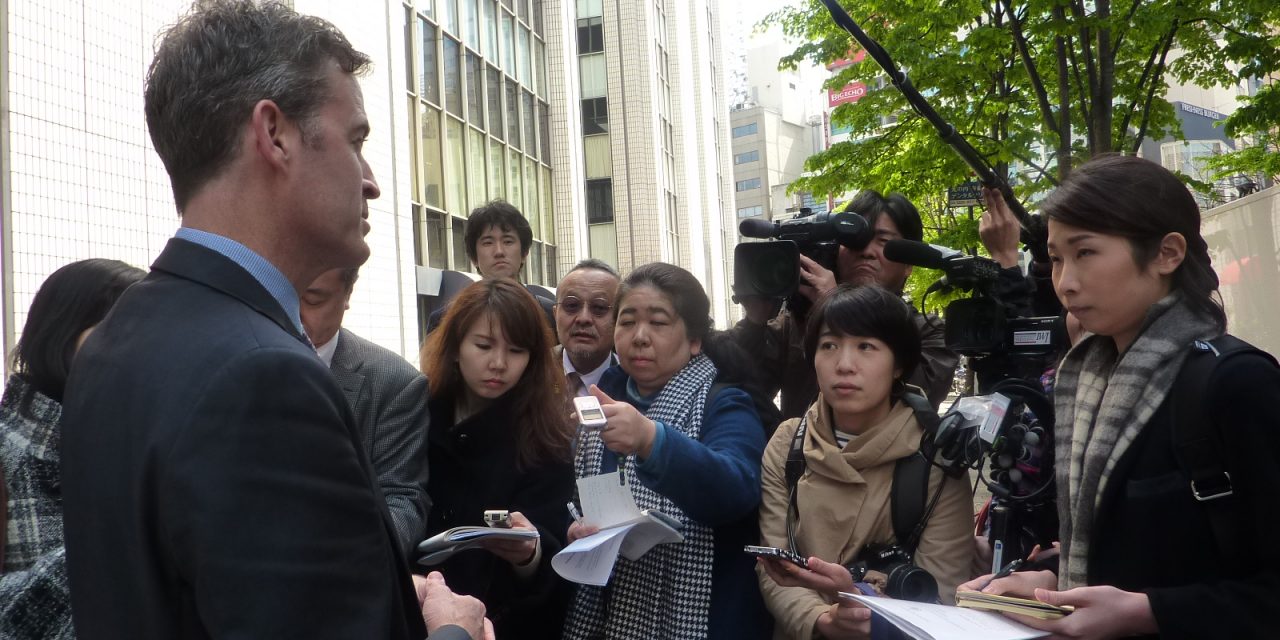By Dr Sanae Fujita, Fellow of the Human Rights Centre, School of Law, University of Essex
New research and analysis supports the UN Special Rapporteur David Kaye’s findings from his 2017 Japan report and presents fresh cases pointing to need for remedial actions by the Japanese government.

Dr Sanae Fujita
Japan’s record with respect to media freedom and human rights generally has attracted little international concern compared to a number of other countries in East Asia. Yet just two years ago, after a somewhat uneasy country visit there, the UN Special Rapporteur on Freedom of Expression, David Kaye, reported discovering “widespread concern”[1]’ among Japanese journalists and others. In a wide-ranging report afterwards, he recommended significant changes to Japanese laws and policies to address what he called ”significant worrying signals”[2], including the application of direct and indirect pressure by government officials towards the media.[3] In the following year the Universal Periodic Review (UPR), conducted at regular intervals by the UN Human Rights Council, also expressed concerns about media independence in Japan, and recommended to the Government that it should remove the existing basis in law for what some regard as undue government interference.[4] Based on my own experience as a researcher active both in Japan and in Europe, I believe that while legal reforms in Japan are indeed essential, the real problem goes deeper. It lies in the weak understanding in Japanese society of the concept that the fundamental role of the press is to play a ‘watchdog’ role in the interest of the wider public. In this article I will attempt to throw light on the nature of Japan’s blurred understanding of press freedom.
Japan’s kisha clubs: the core of the ‘independence problem’
Japan’s Broadcast Act enshrines the so-called “fairness principle” of upholding balance and impartiality in public broadcasting. It also gives the government the legal authority to stop the broadcasting of material which violates that principle. This power became headline news in 2016 when the Internal Affairs and Communication Minister, Sanae Takaichi, publicly warned broadcasters that the government has the power to order broadcasters to suspend operations if they continued to air TV programming that is deemed to be politically biased. Her remarks were made in the context of a row about alleged behind-the-scenes government pressure to force out a number of prominent newscasters known for their challenging style in interviews with ministers. Opposition politicians had claimed that the conservative government of prime minister Shinzo Abe was seeking to tighten its grip on the media. David Kaye reflected those developments in his assessment that “media regulation in Japan is not legally independent of government, in particular not from the political party in power at any given moment.”[5]
The UN Special Rapporteur was also harshly critical of Japan’s elaborate and comprehensive system, of kisha clubs, which has long been the principal means by which mainstream media gather and report the news in each sphere of public and business life. The kisha club system was originally established as a safeguard against excessive government secrecy, to ensure that government officials and others would regularly make themselves available to journalists and provide information to them. But David Kaye concluded that the system functioned instead as a tool to limit free access to information. Indeed critics have long held the clubs responsible for a pattern of Japanese press behaviour in which journalists hold back from hard-hitting reports on issues likely to cause embarrassment to the government. In practice it is evident that kisha club reporters do not challenge Government authority as strongly as those in the UK and other western countries, and investigative journalism is a rarity in Japan.
The supposed merits of the system have in fact been undermined because kisha club membership has largely been confined to reporters from the major media titles only. The clubs limit access to their press conferences to their own ‘club’ members, so excluding a wider range of journalists from covering that ‘beat’, and – critics say – fostering a climate of cosiness or collusion between officials and journalists. For example, as prime minister Mr Abe gives weekly press conferences to the ‘PM’s kisha club’. But they last for only 30 minutes, and he generally uses up the first half of the time making announcements, so that only 15 minutes are left for questions from reporters. Club members do not question this arrangement. And there is an unwritten rule that reporters do not ask follow-up questions. In actual fact, officials seek to forestall “unexpected questions” by gathering up and vetting questions from the various reporters in advance.
This cosy system was exposed to the glare of international publicity during the UN General Assembly session in 2015. When Mr Abe held a press conference at UN headquarters in New York with his usual bevy of ‘club reporters’ in attendance, five journalists were chosen to ask questions. Among them two were foreign media journalists. Reportedly, an official handed a note to the prime minister to tell him which reporters would be asking the questions and in what order. Unlike the docile reporters of Mr Abe’s regular kisha club, when the time came for the foreign reporters to ask their questions, they pressed the Japanese leader to say more with searching follow-up questions. Mr Abe and his accompanying Japanese reporters were visibly taken aback. The prime minister was clearly embarrassed and the press conference was soon discontinued.
That awkward encounter between a Japanese leader and the direct style of the international media went viral after a Japanese internet media, AiAsia, made headlines out of it and called the press conference a ‘farce’. Needless to say, the managed style of Mr Abe’s encounters with the press at home remains unchanged.
The “Mochizuki incident”
The unspoken rule among kisha club reporters that they should routinely give prior notice of questions and refrain from hard-hitting follow-ups made headlines again in June 2017. During a press conference by the Chief Cabinet Secretary, Yoshihide Suga, a woman reporter from Tokyo Shimbun caused a major stir when she broke the custom of self-restraint in spectacular fashion. The government was seeking to contain a scandal in which prime minister Abe and his wife were potentially implicated. It concerned an allegation of cronyism over the suspicious sale of some government-owned land on favourable terms to a developer who reportedly had personal ties to Mr Abe and his wife. The reporter, Isoko Mochizuki, showed no restraint in bombarding the government spokesman with probing questions about the lack of clarity about the story and the government’s failure to resolve it through a thorough investigation. Her questioning went on for some 40 minutes, and apparently helped to force the authorities to promise a full investigation of the affair.

Sanae Fujita lectures at universities in Japan
Ms Mochizuki herself said she had behaved as she did because she did not belong to the political desk and had not known the unspoken rules of its kisha club. Her behaviour showed what is possible even in that conservative reporting environment. In my observation, such dogged questioning of a public figure to get at the truth of a matter of public interest would be seen in Britain or other western countries as evidence of laudable talent. In Japan it brought Ms Mochizuki a good deal of opprobrium from some quarters. She reportedly suffered severe online harassment and even a death threat. However her contribution to the cause of media independence in Japan may come to be seen as considerable: through her determination and courage in the face of disapproval she showed others what need to be done for the press to fulfil its role as a public watchdog.
Shiori Ito’s case
A standard criticism of Japan’s kisha club-style newsgathering system is that reporters who are permanently assigned to one ‘beat’ and routinely working in close quarters alongside colleagues in the same ‘club’ are conditioned to depend on what officials tell them rather than making original investigations of their own. That was indeed broadly the conclusion reached by David Kaye, the independent expert appointed to the position of UN Special Rapporteur for Freedom of Opinion and Expression. The case of Shiori Ito, a freelance journalist, again points to a gulf between the standard approach of Japanese journalism and the more inquisitive and confrontational western model.
In 2015 Ms Ito was an intern in a news organisation in Tokyo. Her case is extraordinary because unlike very many other young women in Japan who become victims of rape and suffer in silence, she spoke out. At a press conference she claimed that she had been raped by one of Japan’s best-known television journalists, Noriyuki Yamaguchi, after dining out with him in response to his suggestion he might help her find a job. An investigation was carried out and an arrest warrant was issued against Mr Yamaguchi. However, before the police could effect the arrest the head of criminal investigations withdrew the arrest order without any clear explanation being given; the investigation was dropped and the prosecutor dismissed the case. Suggestions were made that Mr Yamaguchi’s personal acquaintance with prime minister Shinzo Abe might have had something to do with those decisions. At the time the journalist was known to be about to publish a favourable biography of the prime minister.
The mainstream media in Japan paid little or no heed to the case. Despite the celebrity of the man accused and the absence of any public accounting for the sequence of events, there was no great wave of media or public concern about the possible that justice was not being served or that undue influence might have been brought to bear to dismiss the case. No Japanese mainstream media thought it worthwhile to question the sudden decision by the authorities to bury the case after the alleged victim had spoken out. Instead, the New York Times conducted an investigation of its own and published a lengthy and well-sourced article.[6] The BBC also made a TV documentary about the case and broadcast it three times.[7]
People’s understanding of press freedom
I would like to explain why I think it important to question the depth of understanding by people in Japan about the nature and workings of press freedom. The patterns of behaviour shown by Japanese mainstream media seem to speak for themselves. In addition, my experience points to a “perception gap” that is common among many Japanese people regarding the role of media.
I regularly teach and give guest lectures at a number of universities in Japan. I make a habit of asking students this question: where do you think journalists and the media should stand between the side of the citizen and the side of the government? It seems axiomatic that the media should act as a public watchdog by standing on the side of citizens, and asking difficult questions on their behalf. But in most of the classes I have taught, I have found that about 80 percent of university students think that media should be “in the middle”.
When I show students photographs of equipment used for frontline or conflict zone coverage (bulletproof vests with “PRESS” logos, helmets, and specialist broadcasting gear for war zones) they have no idea who uses them or for what. I have deduced that this is partly because the on-screen reporters of Japanese mainstream media seldom go to any combat zone to report. The Japanese media often make use of video footage recorded by foreign news agencies such as AP or Reuters with a Japanese voiceover rather than sending their own reporters and camera crews to areas of conflict with heavy equipment in the eye of danger. Therefore it is hard for ordinary Japanese viewers to realise that such images and information was really gathered by reporters who have taken risks with their lives to get it. They simply do not know how much they owe to those international media members for the ability to receive the news and pictures from the frontline in their living rooms and smart phones.

William Horsley with Dr Fujita at her talk on Human Rights in Japan at the Daiwa Anglo-Japanese Foundation, London, 26 April 2018
This perceived lack of understanding about the essential role of the journalists leads, in my assessment, to a distinctively Japanese reaction and attitude to journalists who have become hostages in hostile environments in Syria or elsewhere. In the UK and other western countries I observe that when a journalist is taken hostage the focus of much reporting is to ask “how can the Government or others help to rescue him or her?”. In Japan, by contrast, a very common reaction among people is to accuse or blame the journalist who went to such a dangerous place and is “causing trouble despite the Government’s warnings”. Again, the tendency is to bow to the authority of the state and not to sympathise with the plight or the courage of the individual concerned.
In 2015 a freelance journalist, Kenji Goto, was killed by ISIS. Another freelance journalist, Junpei Yasuda, has also been a hostage. In both cases, the families of the journalists received a large number of hostile comments, criticisms and even harassment, along the lines of : “This is his fault, why did he have to go to such a dangerous place?” Even in today’s inter-connected world, a persistent language barrier encourages Japanese people to be content with the limited flow of information they get through their own media inside Japan. In practice, Japanese media do not face much direct competition from foreign media for the attention of the Japanese public. The language barrier is remarkably effective.
In my talks and lectures in Japan I emphasize the importance of learning how to see things relatively and in perspective. I show examples of UK media coverage, such as short clips from BBC news, and articles from The Guardian and The Economist. These examples often seem to give a great shock to audiences, especially to young students. According to their feedback, a good many of them begin to realise that in order to see their own world in perspective they really cannot rely on the Japanese mainstream media alone. They need to widen and expand their sources of information. Sometimes they also start questioning the self-censorship and selective blind spots which have come to characterise the Japanese media.
David Kaye’s report was roundly criticised and in parts even rejected by Japanese officialdom. But among those who best understand the value of press freedom and its vital importance for democratic societies, the fact-finding reports of the UN Special Rapporteurs and others are an essential part of the international system of safeguards for fundamental rights and freedoms, as much for people in Japan as in the rest of the world.
The author of this article thanks William Horsley for his editorial assistance.
Photographs © Sanae Fujita
—
[1] “Report of the Special Rapporteur on the promotion and protection of the right to freedom of opinion and expression on his mission to Japan” UN Doc. A/HRC/35/22/Add.1 (29 May 2017) Para.14, available at https://www.ohchr.org/en/issues/freedomopinion/pages/annual.aspx.
[2] “Report of the Special Rapporteur on the promotion and protection of the right to freedom of opinion and expression on his mission to Japan” UN Doc. A/HRC/35/22/Add.1 (29 May 2017) Para.62, available at https://www.ohchr.org/en/issues/freedomopinion/pages/annual.aspx.
[3] Sanae Fujita “Recap of UN Special Rapporteur on Freedom of Expression’s Mission to Japan”
Recap of UN Special Rapporteur on Freedom of Expression’s Mission to Japan
[4] “Draft report of the Working Group on the Universal Periodic Review: Japan* UN Doc. A/HRC/WG.6/28/L.12 (16 Nov 2017) para 6.133. Available at https://extranet.ohchr.org/sites/upr/Sessions/28session/Japan/Pages/default.aspx
[5] “Report of the Special Rapporteur on the promotion and protection of the right to freedom of opinion and expression on his mission to Japan” UN Doc. A/HRC/35/22/Add.1 (29 May 2017) Para.18, available at https://www.ohchr.org/en/issues/freedomopinion/pages/annual.aspx.
[6] Motoko Rich “She Broke Japan’s Silence on Rape” New York Times (29. Dec 2017) https://www.nytimes.com/2017/12/29/world/asia/japan-rape.html
[7] “Japan’s Secret Shame” https://www.bbc.co.uk/programmes/b0b8cfcj


